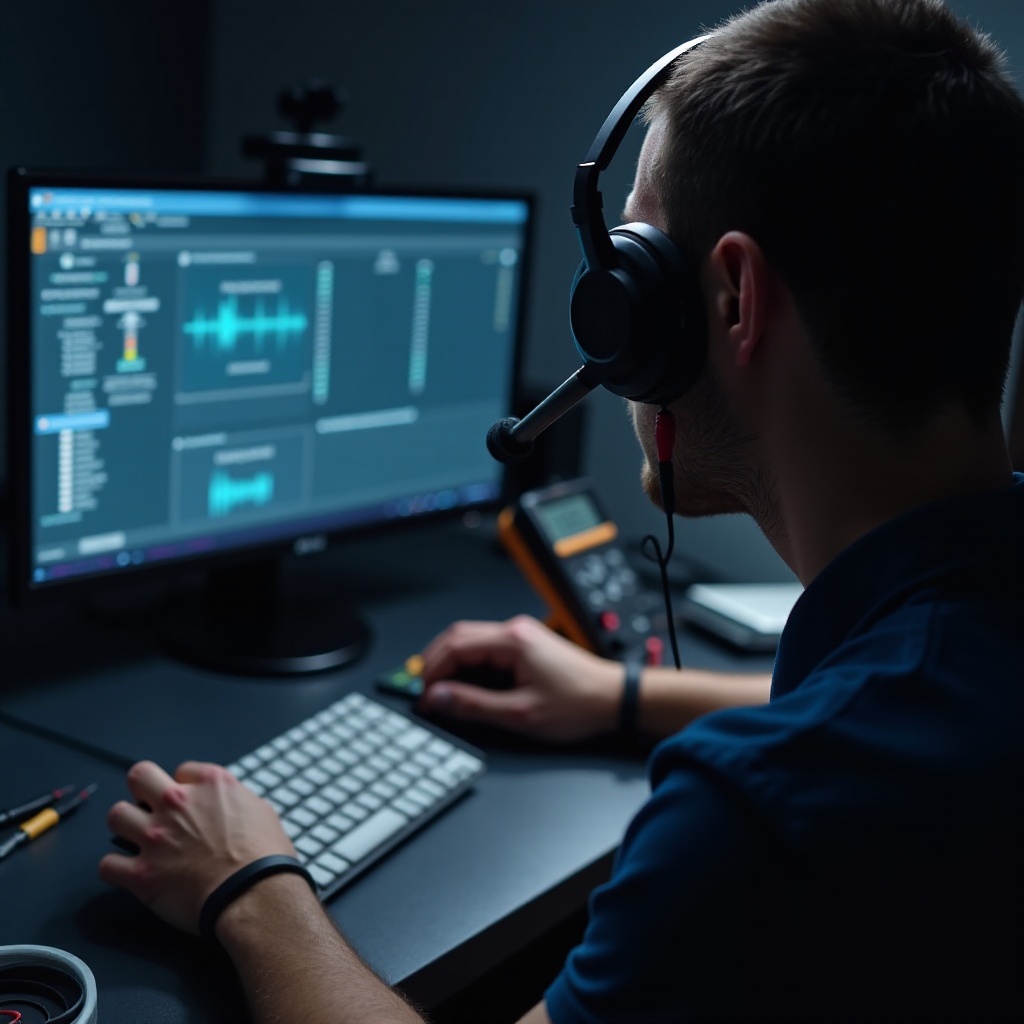
Introduction
Experiencing issues with your Hewlett Packard headset microphone can be frustrating, especially during essential calls or online meetings. These problems can arise for various reasons, including incorrect settings, outdated drivers, or hardware damage. Understanding and resolving these issues is crucial for seamless communication. In this guide, we’ll walk you through diagnosing the problem, applying quick fixes, advanced troubleshooting, hardware checks, enhancing performance, and preventative measures to ensure your headset works perfectly.

Diagnosing the Problem
Before diving into solutions, it’s essential to diagnose the nature of the issue. Is the microphone not picking up any sound, or is it capturing distorted audio? These initial diagnostics will help you identify the underlying cause and apply the appropriate troubleshooting steps.
Identifying the Symptoms
Recognizing the symptoms can rapidly narrow down potential causes:
- No sound is detected when speaking into the mic.
- Sound is too low or muffled.
- Audio distortion or interference.
Check for Recent Changes
Changes in software or hardware configurations can sometimes affect microphone functionality:
- Have you installed new software or updates recently?
- Did the headset work fine before any recent changes on your computer?
Systematic Testing
Testing the headset with different applications and devices can further pinpoint the issue:
- Use the headset with another application like a voice recorder.
- If using an app like Zoom or Skype, try another program to see if the problem persists.

Quick Fixes and Basic Checks
Sometimes, the solution is simpler than expected. Let’s start with some basic steps to ensure everything is set up correctly.
Ensure Proper Connection
- Make sure the headset jack is securely plugged into the correct port.
- If using a USB headset, try a different USB port.
Check Sound Settings on Your PC
Perform these steps to ensure your microphone settings are correctly configured:
1. Volume Settings:
– Right-click on the sound icon in the taskbar.
– Open Sound settings and ensure the microphone volume is turned up.
- Default Device:
- Ensure your HP headset is set as the default recording device.
Confirm Microphone Permissions and Access Settings
Verify that your system and apps have the necessary permissions to access the microphone:
1. Permissions:
– Go to Settings > Privacy > Microphone.
– Ensure your microphone access is turned on and allowed for necessary apps.
Advanced Troubleshooting
If the quick fixes do not solve your problem, advanced troubleshooting might be necessary. These methods delve deeper into potential software issues.
Updating or Reinstalling Audio Drivers
Faulty or outdated drivers are a common cause of microphone problems:
1. Update Drivers:
– Go to Device Manager.
– Expand the Audio inputs and outputs section.
– Right-click your headset and select ‘Update driver.
- Reinstall Drivers:
- Uninstall the current drivers and restart your PC.
- Windows will typically reinstall the correct drivers automatically.
Using the Windows Troubleshooter
The built-in Windows Troubleshooter can often resolve audio issues:
1. Access Troubleshooter:
– Go to Settings > Update & Security > Troubleshoot.
– Select ‘Recording Audio’ and run the troubleshooter.
– Follow the on-screen instructions to identify and fix issues.
Adjusting Advanced Audio Settings in Windows
Fine-tuning audio settings can resolve more subtle issues:
1. Manage Sound Devices:
– Open Settings > System > Sound.
– Under Input, select ‘Device properties.
– Check ‘Additional device properties’ under ‘Related Settings’ and adjust levels and enhancements as needed.
Hardware Checks
If software adjustments fail, it might be a hardware issue. Checking your physical headset and its connections can help identify the root cause of the problem.
Inspecting the Headset for Physical Damage
Examine your headset for any visible wear and tear:
– Look for damage on wires, connectors, and the microphone.
– Ensure all components are securely attached and intact.
Testing the Headset on Different Devices
Using the headset with other devices can help determine whether the issue is with your headset or your computer:
1. Alternate Device:
– Try using the headset with another computer or device.
– If it works, the issue may be with your initial PC’s settings or hardware.
Considering the Purchase of a New Headset If Hardware is Faulty
If your headset is physically damaged and does not work on other devices, it might be time for a replacement:
– Research and purchase a well-reviewed new headset compatible with your needs.
Enhancing Mic Performance
Improving microphone performance can greatly enhance your overall communication experience.
Using Microphone Boosting Techniques
Boosting your microphone’s sensitivity can help if your voice level is too low:
1. Boost Mic Settings:
– Right-click the sound icon in the taskbar.
– Select ‘Open Sound settings,’ then ‘Device properties.
– Adjust the ‘Microphone boost’ slider if available.
Reducing Background Noise and Interference
Minimizing background noise is crucial for clear audio:
1. Noise Cancellation:
– Enable noise suppression features if available in your sound settings.
– Use software solutions like RTX Voice.
- Environment Optimization:
- Use the headset in a quieter environment.
- Avoid placing microphones near noisy electronic devices.
Adjusting Mic Sensitivity and Levels
Optimizing mic sensitivity can further refine audio quality:
1. Sensitivity Adjustments:
– Access Sound settings via the taskbar sound icon.
– Adjust the sensitivity and volume levels to eliminate background noise and capture clear audio.
Preventative Measures
Maintaining the quality and functionality of your headset is vital.
Regularly Updating Drivers and Firmware
Ensure your PC’s drivers and firmware are regularly updated:
– Keep your operating system and software current to avoid compatibility issues.
Proper Maintenance and Handling of the Headset
Take care of your headset to prolong its lifespan:
– Store the headset in a safe place to avoid physical damage.
– Clean the headset regularly, especially the microphone and ear parts.
Using Compatible and Recommended Setups
Always use the headset with devices it’s compatible with:
– Refer to Hewlett Packard guidelines for compatible setups and connections.

Conclusion
Troubleshooting Hewlett Packard headset mic issues doesn’t have to be a daunting task. By following this comprehensive guide, you’ll be equipped to diagnose problems, apply quick fixes, perform advanced troubleshooting, check hardware, and enhance mic performance. Remember, regular maintenance and proper handling can prevent most issues. Ensuring your headset is in optimal condition will allow you to enjoy uninterrupted and clear communication.
Frequently Asked Questions
Why is my Hewlett Packard headset mic not working on my PC?
Check your connections, ensure the headset is set as the default recording device, and verify that the microphone is not muted. Updating drivers or troubleshooting the settings might also help.
How do I update my HP headset drivers?
You can update your headset drivers via the Device Manager. Simply locate your audio device under ‘Audio inputs and outputs,’ right-click, and select ‘Update driver.’
Can physical damage to my HP headset cause mic issues?
Yes, physical damage to the headset or its components can lead to mic issues. Inspect the headset for visible damage and test it on other devices if necessary. Consider replacing it if it’s found faulty.
